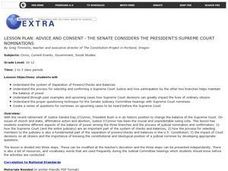Curated OER
Issues Close to Home
Learners discuss their role in their local government. Individually, they use various types of media to examine and take a position on a topic important to them. To introduce their position, they write a letter to the Board of...
Curated OER
Shifting Wins
Students analyze how the outcome of the 2002 midterm elections changed the balance of power in the government. They write a news analysis and evaluation of how the nation be governed in the future.
Curated OER
Celebrate Constitution Day
Learners examine the constitutions structure, content, and underlying philosophy by skimming through as a class then breaking into groups to focus on separate articles. To reinforce learning they individually analyze constitutional...
Curated OER
Advice And Consent - the Senate Considers the President's Supreme Court Nominations
Students study the process and questioning for selecting a Supreme Court Justice. They examine how the decisions of the Supreme Court effect the lives of citizens. They complete worksheets as they study the material.
Constitutional Rights Foundation
Constitutional Rights Foundation: Executive Branch: A Hero Betrayed: The Presidency of Ulysses S. Grant
Lesson with activity on the Executive Branch, distribution of power, scandal and the presidency of Ulysses S. Grant. Includes questions for discussion and class activity. Links to supplemental material.
iCivics
I Civics: Executive Roles: Money Doesn't Grow on Trees?
Young scholars learn the role of the executive branch in creating and carrying out laws and how the executive and legislative branches work together to create a new coin.
Center For Civic Education
Center for Civic Education: Presidents' Day Lessons
Presidents' Day lessons for Grades 10-12 on the constitutional legacies of George Washington, James Madison, Abraham Lincoln, and Ronald Reagan, and how they shaped the history and Constitution of our nation. Each lesson was written and...
iCivics
I Civics: A Very Big Branch
Students learn how the executive departments and agencies regulate and enforce governmental policies, and they explore the roles and responsibilities of the presidential cabinet.
US National Archives
National Archives: Lesson Plans Congress, the President, and the War Powers
Examine the power of Congress to make war by studying primary source documents from various wars throughout U.S. history. Students will analyze how the balance of authority between the legislative branch and executive branch has changed...
iCivics
I Civics: Mini Lesson: Midterm Elections
Students will learn about the midterm election, its role as a referendum on the presidency, and how a shift in party control impacts the legislative and executive branches.
iCivics
I Civics: For the President, All in a Day's Work
Students learn the primary responsibilities of the president and how those duties connect to the powers the Constitution grants to the Executive Branch.
iCivics
I Civics: Foreign Policy: War & Peace and Everything in Between
Students learn the distinction between foreign and domestic policy and what role the executive branch plays in foreign policy and the primary tools it uses: foreign aid, the military, and treaties.
TED Talks
Ted: Ted Ed: How Do Executive Orders Work?
The framers of the American Constitution made the executive power available to the executive branch. But what exactly is this tool, how does it work, and what's the extent of its power? Christina Greer explains.
iCivics
I Civics: Mini Lesson: Executive Orders
Students discover how presidents use executive orders to wield power and how the legislative and judicial branches support and challenge these measures.
iCivics
I Civics: Our Courts: Constitution Day Lesson: Checks and Balances [Pdf]
Students learn the roles and responsibilities of each branch of government and where the checks and balances are located in this role-playing lesson. Requires Adobe Reader.
C-SPAN
C Span Classroom: Teaching About Gridlock
Learning module and lesson plan with C-SPAN video resources and related articles for students to examine and deliberate on whether or not the President should exercise executive powers during times of Congressional gridlock.
iCivics
I Civics: Separation of Powers: What's for Lunch?
Learners find out how the three branches of government interact with each other and how decisions about laws are made by several parts of the U.S. government.
US National Archives
Nara: Teaching With Documents: The Treaty of Guadalupe Hidalgo (Activity)
The National Archives and Records Administration (NARA) provides a lesson, focusing on the treaty of Guadalupe Hidalgo, that relates to the power granted to the President and the Senate to make and approve treaties with foreign nations...
iCivics
I Civics: Cabinet Building
This lesson takes a look at the history of the presidential cabinet, how the cabinet is built through the confirmation process, and why this elite group of people matters to you.
Other
Usa Gov: Three Branches of Government
Lesson plans for students to learn about the three branches of government. They can find information about the origins of the Constitution, separation of powers, and details about each of the three branches.
iCivics
I Civics: Mini Lesson: Vice President
Find out about the importance of the vice presidential candidate in a presidential election, how this person is more than a running mate, the history of the office of the vice presidency, and the modern role of the VP.
PBS
Pbs News Hour: Supreme Court Confirmation Simulation (Lesson Plan)
A lesson that engages learners in a simulation exploring the fundamental roles of the executive branch and the Senate in the judicial selection process. Students will participate in a mock judicial hearing to confirm a Supreme Court...
SMART Technologies
Smart: Branches of the Us Government
This interactive lesson can be used to introduce or to review the three branches of the United States government: legislative, executive, and judicial.
South Carolina Educational Television
Know It All: Government Simulation
Fourth graders will complete a government simulation where they learn about the different responsibilities of each branch of government by becoming the different branches.








